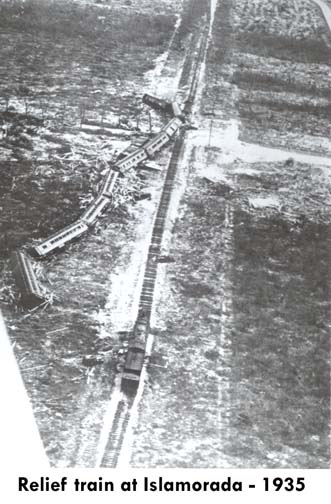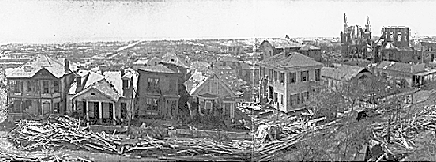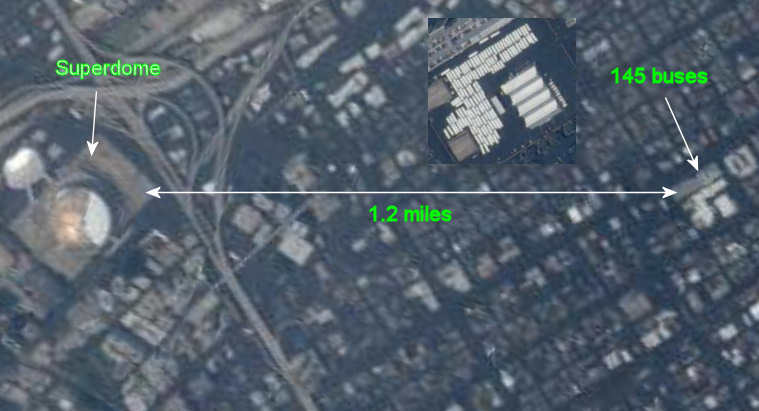
Posted on 09/05/2005 1:48:32 PM PDT by Polybius
In order to understand the Katrina disaster, it is crucial to understand the concept of "Storm Surge".
In New Orleans, the evacuattion plan was particularly crucial because New Orleans was in the Storm Surge Zone, it was below sea level, its levies were only designed for a Category 3 and Katrina was forecast as a Category 5.
I wrote a post explaning the issue of "Storm Surge" to another Freeper who does not live in Hurricane Ally. The subsequent feedback I got from other Freepers said it was very educational. So, I decided it would benefit from its own thread.
That post is reproduced below and I hope it is informative to those who think that a hurricane is a hurricane is a hurricane no matter where you happen to be.
It also illustrates why the failure to evacuate New Orleans' 200,000 low-income residents by the Governor of Louisiana and the Mayor of New Orleans was totally inexcusable.
"...... Where exactly you were going to suggest they take all these people?", I was asked in the original thread:
**********************
Well, being from ( X ), you probably have very little experience with hurricanes. Since my family has lived in Hurricane Ally for over 140 years, I do.
Where do you take those people?
OUT OF THE STORM SURGE ZONE!!!!
ANYWHERE out of the Storm Surge zone!
It does not matter where they end up....in Baton Rogue, in Georgia, in Texas or in Timbuktu.
You get them the h#ll OUT OF THE STORM SURGE ZONE!
"Ummm....What's a Storm Surge?", people from ( X ) ask.
This is what a "Storm Surge" is": Post 11 of this thread

This is what a Storm Surge does:

This is how people who are left stranded in a Storm Surge area end up.....259 war veterans WPA workers aboard that train died in that 1935 Labor Day Hurricane :

The 1935 Labor Day Hurricane Storm Surge literally wiped the Town of Islamorada off the map.
The 1900 Galveston Hurricane Storm Surge destroyed Galveston and killed 6,000 people.

A 1933 hurricane storm surge not only totally destroyed the Cuban town of Cayo Cristo and every human being and every building in that town. It also washed away the entire friggin' island! Afterwards, an entire ISLAND was no longer on navigational charts.
That is why the Mayor of New Orleans beat feet to Baton Rogue. Baton Rouge is OUT OF THE STORM SURGE ZONE.

By contrast, New Orleans is not only in the Storm Surge zone but also BELOW SEA LEVEL. It's levies were not designed for anything greater that Category 3 and Katrina was forecast as a Category 5.
"But no city offered to take them in and ....whine, whine"
BRAVO SIERRA!
Eight hundreds thousand (800,000) other resident of New Orleans got out of the Storm Surge Zone and they were just absorbed into the rest of the United States.
Another 200,000 is totally irrelevant.
On top of that, Bush requested to Federalize the entire evacuation and the Democrat Governor refused.
The New Orleans Hurricane disaster plans called for COMPLETE evacuation of New Orleans precisely BECAUSE IT WAS IN THE STORM SURGE ZONE.
The Southern Louisiana Evacuation Plan specifically stated that people without private transportation were to be transported on public buses.
There were not just "200 buses". There were 200 buses in just one photo and Freepers studying the post-Katrina satellite images have counted over 400 buses altogether at other city parking.
At 70 people per bus that is 28,000 people per round trip that could have been taken out of the storm surge area in the 48 hours prior the Katrina striking.
After the storm hit, what makes you think that buses sent from outside of New Orleans could drive through the flooded mess any better than the 145 New Orleans city buses that were parked 1.2 miles away from the Superdome?

Was Scotty supposed to beam the outside buses to the Superdome and them beam them back out so that they would not have to drive through impassable roads?
The time to evacuate those 200,000 low-income people on public buses OUT OF THE STORM SURGE ZONE was BEFORE the Category 4 storm struck.
That was what the Southern Louisiana Evacuation Plan for New Orleans specifically called for.
The Democrat Governor and the Democrat Mayor did NOTHING to carry out that portion of the plan. They left 200,000 low-income resident abandoned and they now blame the Federal Government for not having Scotty beam down a massive logistics effort after a human disaster of their own making.
Ping.
Send you friends over if they need Hurricane 101 education.
I have a question about storm surge; am I correct in assuming it's not just ONE surge, but it's repeated waves, going in and out?
Perhaps you could include some technical information such as: how soon does the surge appear before the storm, what is the power (volume[weight]xvelocity) within a 100 yard section, how far does a Cat 4 surge flow inland at sea level, when does it recede, etc.

After the levees broke, the second crucial thing that happened was Knucklehead Nagin declared New Orleans open season for looters. It appears that that then led to the break down in public order which was the key problem that New Orleans suffered between Tuesday and Friday when the National Guard started to arrive.
Let me know if I am mistaken in my assumptions on where the real problems occurred?
Outstanding post.....
Scary too!
Semper Fi
Here is another illustration of a "surge": the interior of a hurricane is an area of low, low atmospheric pressure. So low, in fact, it acts like a giant vacuum cleaner and actually sucks up the surface of the ocean into a "dome" many feet (20-30 feet?) above normal sea level and hundreds of miles wide. As the 'cane moves, so does this dome, eventually coming ashore. The water rises, but this is no normal tide: it is the dome of sea water that will dump itself on the land as the hurricane moves inland. And NOTHING can stop it.
Yes.
Yes.
And, in a significant storm surge, the pounding waves are above you and you and the town are 10-20 feet under water.

Yes, there was a delay but being in a Storm Surge area, surrounded by lakes, is precisely why the levies failed. Whatever level the lakes were at, the storm surge "topped them off".
It has been predicted for years that the levies would not survive a Category four.
The prediction of when and how much is a science way beyond my mathematical ability:
As far as destructive power, moving water is one of the most pwerful forces in nature and each liter of water weighs 2.2 pounds. That come out roughly to 8 pounds per gallon. Plug that in to acre-feet moving at X mph and the force is gargantuan.
As far as when it recedes, that is after the hurricane passes, except in a "flood bowl" such as New Oreleans surrounded by lakes. In such a case, the lakes are "topped off" putting much strain on the levies long after the hurricane has passed.
Great job. The other factor that adds to the storm surge is a combination of high tides with the storm surge and realy heavy rains upstream. When this happens there is no place for the downstream water to go. It gets hammered back with the surge and causes even more damage. We get hit with this problem in N California in our winters with a heavy storm at sea, inland, high tides and no place for the downstream water to go..
When this happens water becomes non flexible and hammers buildings and even big things the derailed train cars in your picture. This can happen miles upstream.
Again thanks for a great job.
Thanks for this ping to this outstanding and scary thread.
"Southeast Louisiana Hurricane Evacuation and Sheltering Plan" (otherwise known as "Hurricane Evacuation for Dummies")
Available for download here: http://www.ohsep.louisiana.gov/plans/EOPSupplement1a.pdf
(Emphasis and blue text provided for any NOLA and LA people who may be lurking. ).
PART I: GENERAL
A. SUMMARY:
The Southeast Louisiana Hurricane Evacuation and Sheltering Plan is intended to provide a framework within which the parishes can coordinate their actions with State government in order to deal with a catastrophic hurricane. The overall strategy for dealing with a catastrophic hurricane is to evacuate as much of the at risk population as possible from the path of the storm and relocate them to a place of relative safety outside the projected high water mark of the storm surge flooding and hurricane force winds.
(May I repeat that, please? "The overall strategy for dealing with a catastrophic hurricane is to evacuate as much of the at risk population as possible from the path of the storm and relocate them to a place of relative safety outside the projected high water mark of the storm surge flooding and hurricane force winds.")
......
PART II: SITUATIONS AND ASSUMPTIONS
A. SITUATIONS
.......B. ASSUMPTIONS3. Tidal surge, associated with the "worst case" Category 3, 4 or 5 Hurricane Scenario for the Greater New Orleans Metropolitan Area, as determined by the National Weather Service (NWS) Sea, Lake and Overland Surge from Hurricanes (SLOSH) Model, could cause a maximum inundation of 20 feet above sea level in some of the parishes in the Region, not including tidal effects, wind waves and storm rainfall.
4. The Area is protected by an extensive levee system, but above-normal water levels and hurricane surge could cause levee overtopping or failures.
.......
8. Many of the Region's emergency shelter facilities may be inundated by floodwaters when threatened by a slow moving Category 3 or above hurricane. Sheltering of evacuees outside of the Region becomes necessary. Repeat after me, everybody: "Sheltering of evacuees outside of the Region becomes necessary."
.....(Insert the bus photos here.)5. The primary means of hurricane evacuation will be personal vehicles. School and municipal buses, government-owned vehicles and vehicles provided by volunteer agencies may be used to provide transportation for individuals who lack transportation and require assistance in evacuating.
.....
14. Hospitals, nursing homes, group homes, etc. will have pre-determined evacuation and/or refuge plans if evacuation becomes necessary. All facilities will have approved Multi-Hazard Emergency Operations Plans as mandated by the State of Louisiana, Dept. of Health and Hospitals (DHH). Before operating permits are given to homes/hospitals, emergency precautions are to be taken, such as the placement of emergency supplies and equipment (i.e., generators and potable water) on upper floors. .....
23. As evacuation routes are closed, people who are still in the risk area will be directed to last resort refuge within the area.
(Not before, but a-f-t-e-r. After the evacuation routes are closed due to deteriorating weather conditions, people in the Staging Areas who have not gotten out should be directed to Last Resort Refuges. As in....... the Superdome.)
PART III: EVACUATION (p. 16)
A. PROCEDURES:
The procedures outlined here are the minimum actions that will be required from State, parish and municipal authorities in a hurricane emergency, to move as many people as possible from the areas threatened by the hurricane storm surge as identified by the U. S. Army Corps of Engineers' SLOSH estimates.
(May I repeat that, please? "....the minimum actions that will be required from State, parish and municipal authorities in a hurricane emergency, to move as many people as possible from the areas threatened by the hurricane storm surge.")
B. CONCEPT OF OPERATIONS: The Regional Evacuation Plan has three phases: Precautionary, Recommended and Mandatory. Each phase requires specific actions to be taken at about the same time by all the organizations that are operating under this plan. The cycle of Decision, Implementation and Information Feedback is critical to the operation of this plan.
3. Mandatory Evacuation: (p. 20)
c. State of Louisiana:a. Risk Area Parishes: (i.e., parishes in the storm surge areas)
4. Designate staging areas and other facilities as last resort refuges. People at these locations who cannot be evacuated in time to avoid the storm will remain and take refuge in the designated buildings.
(Notice this does not say, "People at these locations will remain..." No, the Disaster Plan states, "People at these locations who cannot be evacuated in time will remain...")
4. Direct the evacuation and shelter of persons having mobility limitations, including persons in nursing homes, hospitals, group homes and non-institutionalized persons.(Insert story of the 80 nursing home residents who drowned here.)
PART IV: Evacuation Routes (p. 24)
A. Highways:
There are several major evacuation routes out of the Southeastern Louisiana Hurricane Risk Area.
B. Concept of Operations:.....
4. As a hurricane approaches land, high winds and rising water will affect evacuation routes, making travel hazardous. Evacuation orders will take this into account and provide for evacuation routes to be shut down at the point at which travel would become hazardous.
5. As evacuation routes are shut down, people who are still in the risk area will have to be directed to last resort refuge buildings within the area. (Apparently this is repeated for emphasis. For previous references to this underlying assumption and vital concept of the Disaster Plan, see Part II, B, 23 and/or Part III, B, 3, a, 4 above.)
1. Evacuation will be conducted in three phases as outlined in the basic plan: Precautionary / Voluntary, Recommended and Mandatory.(For elected officials of NOLA and LA (and you know who you are), that means residents of "storm-surge areas.")......c. Mandatory:
1. Priority will be given to residents of low-lying areas.
PART VI: STAGING AREAS / LAST RESORT REFUGE
A. Staging Areas (think "Superdome.")
The definition of a staging area is a central location, easily accessible to those ambulatory people who are in need of transportation to a shelter. ("Shelter" means a place out of the storm surge area. A place with food and water. The Superdome is not a Shelter.)1. Residents who have no means of transportation will be directed to the staging areas
(Superdome).
2. Transportation vehicles (insert bus pictures) will be pre-positioned to transport residents to shelters. 3. Once the evacuation routes are closed (Okay! We got it already! Once the weather gets too bad to travel...), the staging areas will become Last Resort Refuges.
4. After the storm has passed and the evacuation order is rescinded, transportation will be provided to return people dropped off at shelters to the staging area.
Please Note: This section of the Disaster Plan could not have been implemented. "Why," you ask? Because the levees failed. All the buses and the thousands of lower income, people-without-cars who would have been in those buses would not have been allowed back to the main Staging Area (i.e., Superdome).B. Last Resort Refuge (think "Superdome") The definition of Last Resort Refuge is a place for persons to be protected from the high winds and heavy rains from the storm. Unlike a shelter, there may be little or no water or food and possibly no utilities. A Last Resort Refuge is intended to provide best available survival protection for the duration of the hurricane only. (Do I really need to repeat that? Simply stated, this means that a "Last Resort Refuge" is a place where people go when they cannot get on a bus and make it to a Shelter before the weather gets bad.)Instead, the buses and the thousands of lower-income people would have been forced to stay at the shelters -- those places of sanctuary that are outside of the storm surge area and that are stockpiled with food and water so the people-without-cars won't die.
1. Once evacuation routes are closed, people who were unable to evacuate the risk area(on all those buses) will be directed to last resort refuge and /or staging areas. (Sigh. There it is again. It must be important! For NOLA & LA officials, see Part II, B, 23, Part III, B, 3, a, 4, and/or Part IV, A, 5 above.)
2. When it is determined that weather conditions permit, rescue teams will be sent into areas designated for Last Resort Refuge (Superdome) to transport evacuees to designated shelters (Astrodome).
Congratulations, NOLA and LA officials -- you did this one (with Bush's help)......
g. Last resort refuge inside the risk area will be the responsibility of the local parish government.
g. Last resort refuge inside the risk area will be the responsibility of the local parish government.g. Last resort refuge inside the risk area will be the responsibility of the local parish government.
g. Last resort refuge inside the risk area will be the responsibility of the local parish government.
g. Last resort refuge inside the risk area will be the responsibility of the local parish government.
g. Last resort refuge inside the risk area will be the responsibility of the local parish government.
.....
bump
Disclaimer: Opinions posted on Free Republic are those of the individual posters and do not necessarily represent the opinion of Free Republic or its management. All materials posted herein are protected by copyright law and the exemption for fair use of copyrighted works.